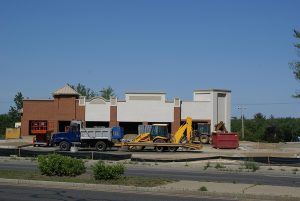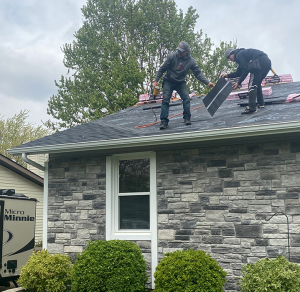Many homeowners are not aware of hail damage on their roofs. Hail damage to rooftops often times cannot be seen from the ground, and that’s a big reason why the idea of hail damage hardly ever crosses a homeowner’s mind. Because of this, it is wise after a hail storm to get up on your roof and inspect it for any hail damage.
When doing this, it’s nice to use conventional chalk codes for hail damage on your roof. Today, we’re going to provide a set of chalk codes that can be used in marking areas of wear or damage on roofs to assist in photo documentation of roof conditions.
Basic Codes
Chalk codes for hail damage made on your roof by a local inspector or roofer are intended to aid in photo-documentation of roof conditions at the time of the inspection. It’s also to note the inspector’s opinion about the cause of wear or damage. Sharp close-up photographs of your roof’s surface can often make quite clear the type of roof wear or damage at that site.
Circle Slash Roof Damage Marking Code
The inspector uses the circle/slash to show an area of the roof where there was no damage or loss due to hail hits or hail damage.
“FT” Roof Damage Marking Code
By convention, some roof inspectors use FT to indicate granule loss or other roof surface damage due to foot traffic or walking-on traffic.
“HD” Roof Damage Marking Code
This mark can be used to mark example areas of roof damage due to hail or ice striking the roof surface. A roof inspector might also use this mark to indicate where they were going to recommend removing a shingle for testing or submission to a manufacturer.
Codes For Photography
It’s the standard operating procedure for inspectors to use chalk marks to indicate specific observations on a roof that need to be photographed. Inspectors use chalk usually to mark or indicate the following:
F or R or N, S, E, W are used to indicate the particular roof slope on which the photograph was taken.
Circles, lines, or arrows to indicate roof areas of hail damage or hail hits. It also indicates mineral granule loss due to scouring or other specific damage to be identified in the roof inspector’s report.
SPLT + arrows mark roof areas where there are shingle splits that may be hard to see without up-close access.
R/R or R&R or CUT mark a roof area where a shingle is to be removed (and patched) for independent lab testing.
Common Roof Damage Chalk Codes For Hail Damage Including Slope Identification
Some insurance claims investigators include in their chalk marks both the type of damage and an indicator of which roof slope was involved. This is a great idea since the orientation of the roof slope may not be evident in roof damage photos. Also, differences in damage found on different roof slopes can be diagnostic in assigning a damage cause.
Table Of Common Roof Damage Chalk Mark Codes Including Slope Identification | ||
Roof Slope | Damage Type | Marking Code – Slope – Damage Type |
North Slope | Foot traffic | NFT |
Granule Loss | NGL | |
Hail | NH | |
Hail (alternative) | NHD | |
Nail Pop | NNP | |
No Damage Visible (reference area for comparison) | NNDF (no damage found) or use circle/slash symbol | |
Pock Mark | NP | |
Area to be cut for further testing | R/R or R&R or CUT | |
Splits (thermal splitting) | NSPLT | |
Wear/Tear (normal aging) | NW/T | |
South Slope East Slope West Slope or Front Slope / Rear Slope, Etc. | Use same damage types | Change roof damage marking code first letter to correspond to the roof slope facing direction: S = South Slope Example: Hail damage code = SH E = East Slope Example: Nail pop code = ENP W = West Slope Example: Granule loss code = WGL Use F, R, for front or rear slopes if you prefer. However since the rough compass-facing direction of roof slopes can assist in relating damage to the known direction of winds, rain, or hail storms, the compass directions used above are more helpful. |
Other Roof Condition Details To Be Photographed and Recorded: Rulers and Scale Indicators
In your own roof inspections, it’s wise to place a ruler or other indication of scale in some photographs. You should also take several closeup macro-photographs to clearly indicate instances of pitting, thermal splitting, mechanical damage, and more.
Another great tip is to photograph the entire field of the roof and prepare comparative photographs of both damaged and un-damaged roof areas. Photographs that allow comparison of the condition of roof slopes facing different directions, at different pitches, and more are also a really great idea.
Any roof inspection is incomplete without a site and building inspection that identifies other conditions that might affect the roof. Even a wet or flooding basement or crawl area can have a significant impact on the condition of a building roof. That moisture moves up through the building and into the attic or roof cavity, causing huge and expensive issues.
Size of Roof Test Square When Reporting Hail Damage
Some inspectors suggest marking off a 10′ x 10′ test square area and counting the number of hits or marks ascribed to hail damage as a step in assessing the extent of hail damage to a roof. This approach has some sense to it in that it attempts to get past arm-waving speculation about the extent of damage to a roof.
But the roof damage test square approach can have some shortcomings too, depending on how it is applied. Just counting marks indicating hailstone strikes do not adequately consider the depth of damage or the degree to which the roof shingle has been exposed. And choosing an area for a test square is vulnerable to subjectivity or deliberate skewing of the report results. For example, choosing as a test square a roof slope that was by its orientation less damaged or not damaged at all compared with other roof slopes on the same building will give an inaccurate assessment of the building’s roof system.
Final Thoughts
We hope this helps you decode some of the “code” that chalk codes for hail damage can look like. If you are ready for a new roof, need a roof repair or cleaning, or anything else, give us a call at 636-699-0449.





